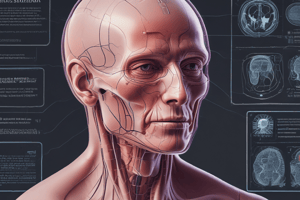Podcast
Questions and Answers
What does resolution primarily refer to in diagnostic imaging?
What does resolution primarily refer to in diagnostic imaging?
- The size of the images printed
- The color depth of an image
- The speed at which an image can be processed
- The ability to differentiate between structures (correct)
How does a high-resolution image enhance its quality?
How does a high-resolution image enhance its quality?
- It maximizes contrast levels
- It simplifies the composition of colors
- It has more pixels allowing for greater detail display (correct)
- It reduces the file size considerably
Which of the following best describes a characteristic of low-resolution images?
Which of the following best describes a characteristic of low-resolution images?
- They capture more detail than high-resolution images
- They use more color variations than high-resolution images
- They are typically faster to load and process
- They display fewer pixels and less detail (correct)
In diagnostic imaging, an increase in the number of pixels generally results in what?
In diagnostic imaging, an increase in the number of pixels generally results in what?
What effect does a high-resolution image have on medical diagnostics?
What effect does a high-resolution image have on medical diagnostics?
Flashcards
Image Resolution
Image Resolution
The ability of an image to show fine details, determined by the number of pixels.
Pixel
Pixel
A tiny square that makes up a digital image. More pixels mean a sharper picture.
High-Resolution Image
High-Resolution Image
An image with a large number of pixels, allowing for detailed visualization of small structures.
Low-Resolution Image
Low-Resolution Image
Signup and view all the flashcards
Diagnostic Imaging and Resolution
Diagnostic Imaging and Resolution
Signup and view all the flashcards
Study Notes
Resolution in Diagnostic Imaging
- Resolution describes the ability to distinguish structures.
- In imaging, resolution relates to the number of pixels in an image.
- Higher resolution means more pixels, enabling more detail in the display.
Studying That Suits You
Use AI to generate personalized quizzes and flashcards to suit your learning preferences.




